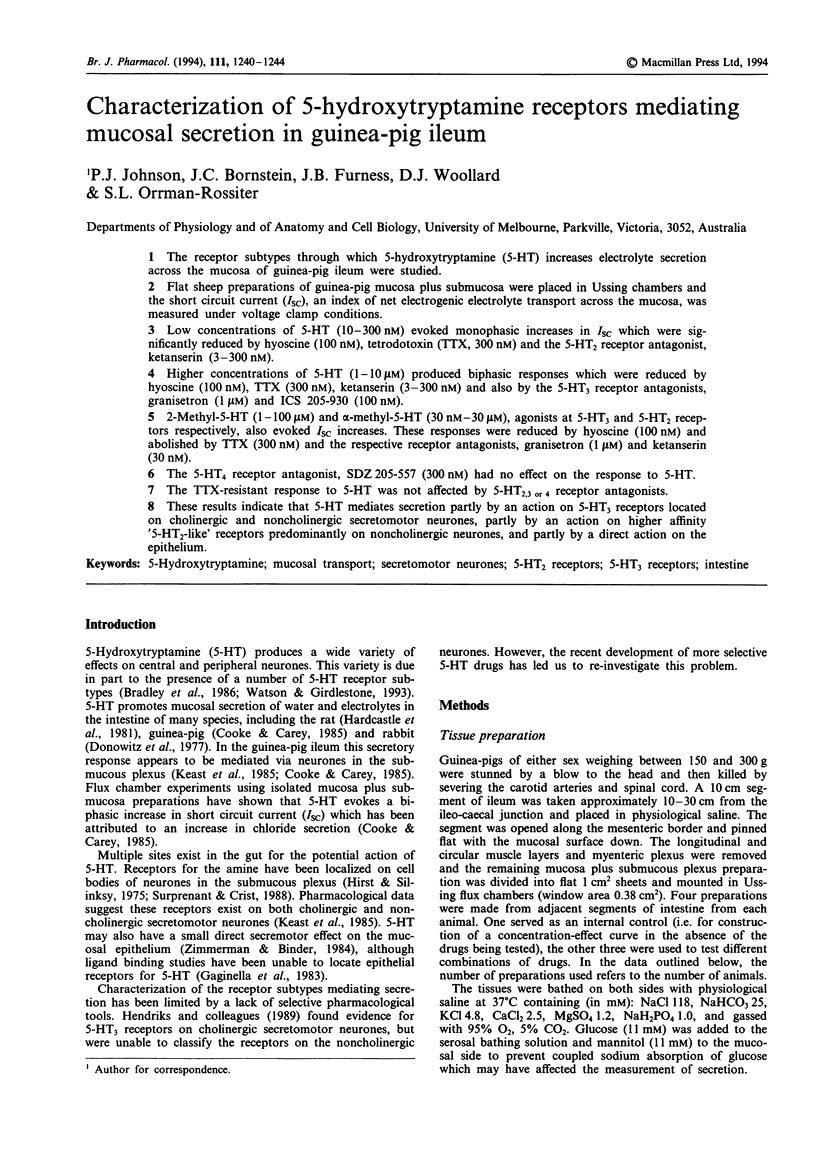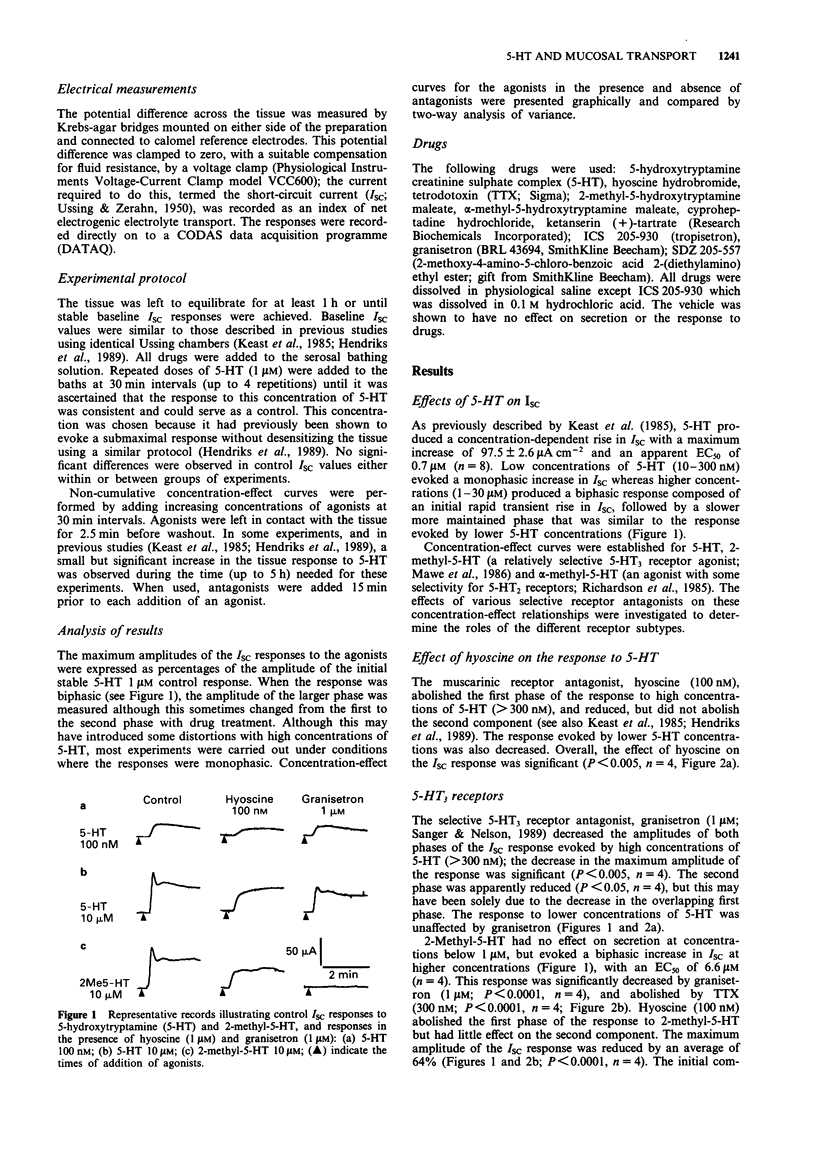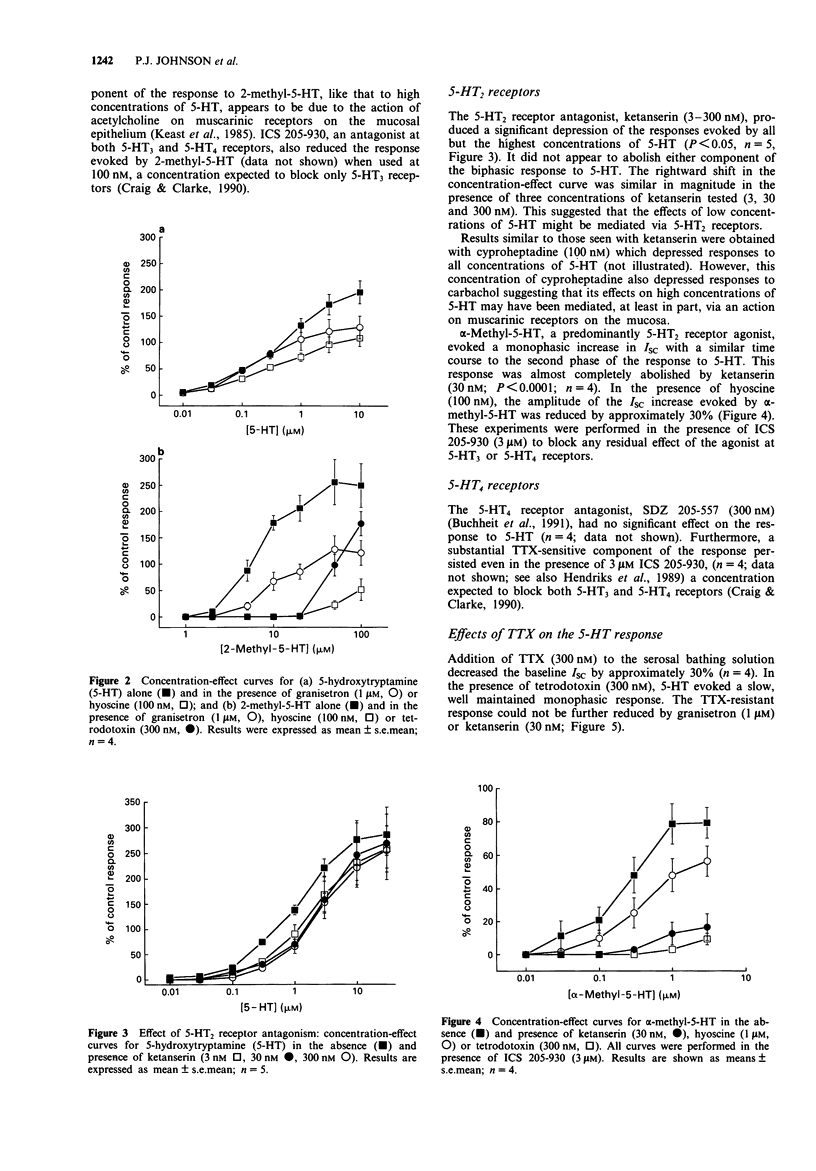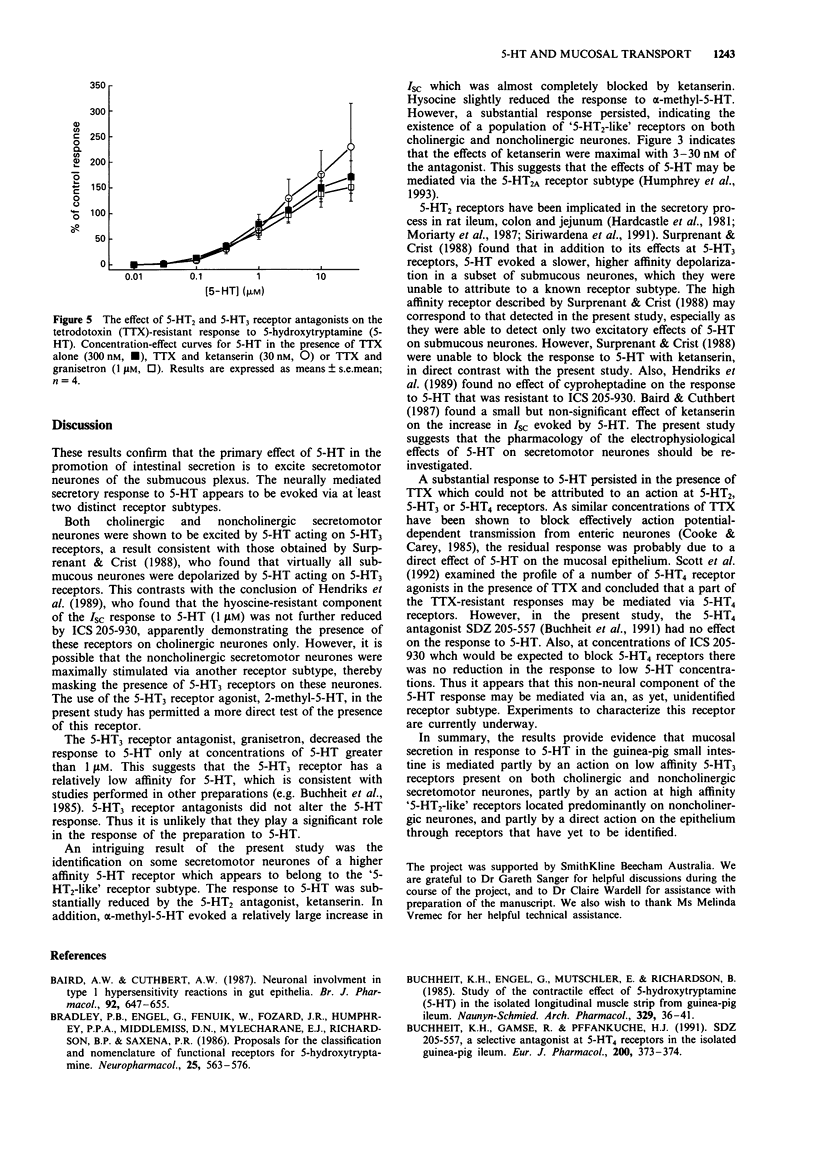Abstract
1. The receptor subtypes through which 5-hydroxytryptamine (5-HT) increases electrolyte secretion across the mucosa of guinea-pig ileum were studied. 2. Flat sheep preparations of guinea-pig mucosa plus submucosa were placed in Ussing chambers and the short circuit current (ISC), an index of net electrogenic electrolyte transport across the mucosa, was measured under voltage clamp conditions. 3. Low concentrations of 5-HT (10-300 nM) evoked monophasic increases in ISC which were significantly reduced by hyoscine (100 nM), tetrodotoxin (TTX, 300 nM) and the 5-HT2 receptor antagonist, ketanserin (3-300 nM). 4. Higher concentrations of 5-HT (1-10 microM) produced biphasic responses which were reduced by hyoscine (100 nM), TTX (300 nM), ketanserin (3-300 nM) and also by the 5-HT3 receptor antagonists, granisetron (1 microM) and ICS 205-930 (100 nM). 5. 2-Methyl-5-HT (1-100 microM) and alpha-methyl-5-HT (30 nM-30 microM), agonists at 5-HT3 and 5-HT2 receptors respectively, also evoked ISC increases. These responses were reduced by hyoscine (100 nM) and abolished by TTX (300 nM) and the respective receptor antagonists, granisetron (1 microM) and ketanserin (30 nM). 6. The 5-HT4 receptor antagonist, SDZ 205-557 (300 nM) had no effect on the response to 5-HT. 7. The TTX-resistant response to 5-HT was not affected by 5-HT2,3 or 4 receptor antagonists.(ABSTRACT TRUNCATED AT 250 WORDS)
Full text
PDF




Selected References
These references are in PubMed. This may not be the complete list of references from this article.
- Baird A. W., Cuthbert A. W. Neuronal involvement in type 1 hypersensitivity reactions in gut epithelia. Br J Pharmacol. 1987 Nov;92(3):647–655. doi: 10.1111/j.1476-5381.1987.tb11368.x. [DOI] [PMC free article] [PubMed] [Google Scholar]
- Bradley P. B., Engel G., Feniuk W., Fozard J. R., Humphrey P. P., Middlemiss D. N., Mylecharane E. J., Richardson B. P., Saxena P. R. Proposals for the classification and nomenclature of functional receptors for 5-hydroxytryptamine. Neuropharmacology. 1986 Jun;25(6):563–576. doi: 10.1016/0028-3908(86)90207-8. [DOI] [PubMed] [Google Scholar]
- Buchheit K. H., Engel G., Mutschler E., Richardson B. Study of the contractile effect of 5-hydroxytryptamine (5-HT) in the isolated longitudinal muscle strip from guinea-pig ileum. Evidence for two distinct release mechanisms. Naunyn Schmiedebergs Arch Pharmacol. 1985 Mar;329(1):36–41. doi: 10.1007/BF00695189. [DOI] [PubMed] [Google Scholar]
- Buchheit K. H., Gamse R., Pfannkuche H. J. SDZ 205-557, a selective antagonist at 5-HT4 receptors in the isolated guinea pig ileum. Eur J Pharmacol. 1991 Aug 6;200(2-3):373–374. doi: 10.1016/0014-2999(91)90601-l. [DOI] [PubMed] [Google Scholar]
- Cooke H. J., Carey H. V. Pharmacological analysis of 5-hydroxytryptamine actions on guinea-pig ileal mucosa. Eur J Pharmacol. 1985 May 20;111(3):329–337. doi: 10.1016/0014-2999(85)90639-9. [DOI] [PubMed] [Google Scholar]
- Craig D. A., Clarke D. E. Pharmacological characterization of a neuronal receptor for 5-hydroxytryptamine in guinea pig ileum with properties similar to the 5-hydroxytryptamine receptor. J Pharmacol Exp Ther. 1990 Mar;252(3):1378–1386. [PubMed] [Google Scholar]
- Donowitz M., Charney A. N., Heffernan J. M. Effect of serotonin treatment on intestinal transport in the rabbit. Am J Physiol. 1977 Jan;232(1):E85–E94. doi: 10.1152/ajpendo.1977.232.1.E85. [DOI] [PubMed] [Google Scholar]
- Gaginella T. S., Rimele T. J., Wietecha M. Studies on rat intestinal epithelial cell receptors for serotonin and opiates. J Physiol. 1983 Feb;335:101–111. doi: 10.1113/jphysiol.1983.sp014522. [DOI] [PMC free article] [PubMed] [Google Scholar]
- Hardcastle J., Hardcastle P. T., Redfern J. S. Action of 5-hydroxytryptamine on intestinal ion transport in the rat. J Physiol. 1981 Nov;320:41–55. doi: 10.1113/jphysiol.1981.sp013933. [DOI] [PMC free article] [PubMed] [Google Scholar]
- Hendriks R., Bornstein J. C., Furness J. B. Evidence for two types of 5-hydroxytryptamine receptor on secretomotor neurons of the guinea-pig ileum. Naunyn Schmiedebergs Arch Pharmacol. 1989 Apr;339(4):409–414. doi: 10.1007/BF00736055. [DOI] [PubMed] [Google Scholar]
- Hirst G. D., Silinsky E. M. Some effects of 5-hydroxytryptamine, dopamine and noradrenaline on neurones in the submucous plexus of guinea-pig small intestine. J Physiol. 1975 Oct;251(3):817–832. doi: 10.1113/jphysiol.1975.sp011124. [DOI] [PMC free article] [PubMed] [Google Scholar]
- Humphrey P. P., Hartig P., Hoyer D. A proposed new nomenclature for 5-HT receptors. Trends Pharmacol Sci. 1993 Jun;14(6):233–236. doi: 10.1016/0165-6147(93)90016-d. [DOI] [PubMed] [Google Scholar]
- Keast J. R., Furness J. B., Costa M. Investigations of nerve populations influencing ion transport that can be stimulated electrically, by serotonin and by a nicotinic agonist. Naunyn Schmiedebergs Arch Pharmacol. 1985 Nov;331(2-3):260–266. doi: 10.1007/BF00634247. [DOI] [PubMed] [Google Scholar]
- Leysen J. E., Niemegeers C. J., Van Nueten J. M., Laduron P. M. [3H]Ketanserin (R 41 468), a selective 3H-ligand for serotonin2 receptor binding sites. Binding properties, brain distribution, and functional role. Mol Pharmacol. 1982 Mar;21(2):301–314. [PubMed] [Google Scholar]
- Mawe G. M., Branchek T. A., Gershon M. D. Peripheral neural serotonin receptors: identification and characterization with specific antagonists and agonists. Proc Natl Acad Sci U S A. 1986 Dec;83(24):9799–9803. doi: 10.1073/pnas.83.24.9799. [DOI] [PMC free article] [PubMed] [Google Scholar]
- Moriarty K. J., Higgs N. B., Woodford M., Warhurst G., Turnberg L. A. Inhibition of the effect of serotonin on rat ileal transport by cisapride: evidence in favour of the involvement of 5-HT2 receptors. Gut. 1987 Jul;28(7):844–848. doi: 10.1136/gut.28.7.844. [DOI] [PMC free article] [PubMed] [Google Scholar]
- Richardson B. P., Engel G., Donatsch P., Stadler P. A. Identification of serotonin M-receptor subtypes and their specific blockade by a new class of drugs. Nature. 1985 Jul 11;316(6024):126–131. doi: 10.1038/316126a0. [DOI] [PubMed] [Google Scholar]
- Sanger G. J., Nelson D. R. Selective and functional 5-hydroxytryptamine3 receptor antagonism by BRL 43694 (granisetron). Eur J Pharmacol. 1989 Jan 10;159(2):113–124. doi: 10.1016/0014-2999(89)90695-x. [DOI] [PubMed] [Google Scholar]
- Scott C. M., Bunce K. T., Spraggs C. F. Investigation of the 5-hydroxytryptamine receptor mediating the 'maintained' short-circuit current response in guinea-pig ileal mucosa. Br J Pharmacol. 1992 Aug;106(4):877–882. doi: 10.1111/j.1476-5381.1992.tb14428.x. [DOI] [PMC free article] [PubMed] [Google Scholar]
- Siriwardena A., Booker C., Pratt J., Kellum J. M. Pathways of serotonin-induced electrolyte transport in rat distal colon. Surgery. 1991 Aug;110(2):411–418. [PubMed] [Google Scholar]
- Surprenant A., Crist J. Electrophysiological characterization of functionally distinct 5-hydroxytryptamine receptors on guinea-pig submucous plexus. Neuroscience. 1988 Jan;24(1):283–295. doi: 10.1016/0306-4522(88)90331-4. [DOI] [PubMed] [Google Scholar]
- USSING H. H., ZERAHN K. Active transport of sodium as the source of electric current in the short-circuited isolated frog skin. Acta Physiol Scand. 1951 Aug 25;23(2-3):110–127. doi: 10.1111/j.1748-1716.1951.tb00800.x. [DOI] [PubMed] [Google Scholar]
- Zimmerman T. W., Binder H. J. Serotonin-induced alteration of colonic electrolyte transport in the rat. Gastroenterology. 1984 Feb;86(2):310–317. [PubMed] [Google Scholar]


